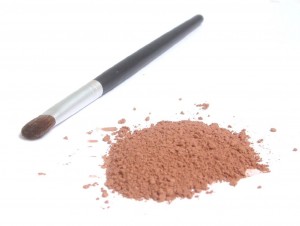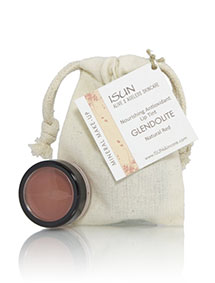Mineral makeup is one of those product revelations that makes you wonder why anything else ever existed in the first place. In short, it’s exactly what its name implies: makeup made entirely of minerals. Of course, as with so many things in the cosmetics industry, there’s a lot of intentional confusion that has been created about it. So, I’d like to clear up some of those misconceptions, and tell you why mineral makeup is so amazing.
What is mineral makeup?
The best mineral makeup tends to have 4 or 5 ingredients at most. In any ingredients list, you’re most likely to see titanium dioxide, zinc oxide, mica oxide, and iron oxide. The minerals used in the makeup I carry are mined from the earth using the best sustainability and green practices available, then they’re cleaned up in a controlled environment to prevent any heavy metal toxicity, and finally oxidized to give them their rich palate of colors.
The ultra fine powders glide on like silk, and the minerals they’re made of offer a whole host of skin benefits, including full UVA/UVB protection and anti-inflammatory properties to help reduce redness and irritation. Mineral makeup is great for sensitive skin or anyone who’s acne or rosacea prone. If you’ve struggled with skin conditions or sensitive skin and thought you could never wear makeup because of it, mineral makeup may be for you.
What about all of those commercial mineral makeups?
At the current level of regulation, mineral makeups only have to contain a tiny percentage of real minerals to be marketed as such, and the other ingredients can include: cheap fillers like talc; toxic parabens; bismuth oxychloride, ferric ferrocyanide, or other skin irritants; and all kinds of dyes and perfumes. Stay away from these ingredients! I’ve written before about these kinds of chemicals here.
How do I choose a mineral foundation?
 Now, once you’ve decided that you want to try mineral makeup, the biggest challenge is choosing a color that will look like you’re not wearing any makeup at all. So, first you need to determine your skin tone. Is it warm or cool? Skin with golden, peach, and olive undertones is considered warm, while skin with pink or blue undertones is considered cool. If you can’t tell by looking closely, or you’re unsure, a quick and easy test is to look in a mirror and hold up a piece of silver jewelry next to your face. Next, hold up a piece of gold jewelry. If you have a cool skin stone, the silver will bring out the glow of your skin and the sparkle of your eyes. If you have a warm skin tone, the gold will. And if both look right for you, you have a neutral skin tone.
Now, once you’ve decided that you want to try mineral makeup, the biggest challenge is choosing a color that will look like you’re not wearing any makeup at all. So, first you need to determine your skin tone. Is it warm or cool? Skin with golden, peach, and olive undertones is considered warm, while skin with pink or blue undertones is considered cool. If you can’t tell by looking closely, or you’re unsure, a quick and easy test is to look in a mirror and hold up a piece of silver jewelry next to your face. Next, hold up a piece of gold jewelry. If you have a cool skin stone, the silver will bring out the glow of your skin and the sparkle of your eyes. If you have a warm skin tone, the gold will. And if both look right for you, you have a neutral skin tone.
After that, you’ll need to match the color to where you plan to apply it, which is most likely your face. Something that the inside of your wrist and your neck have in common is that they don’t get the same amount of sunlight as your face does. So, apply the makeup along your lower cheek, right above the jawline, then look at yourself in natural light. Looking at yourself in natural light is especially important because artificial light can change the way your skin looks.
If one specific color doesn’t work, feel free to experiment with others and blend your own mixtures. Eventually, you’ll find some that you love. Once you see the natural look, the way it improves your skin, and feel the feeling of wearing no makeup at all, you’ll never go back to using anything else.






Whats about makeup that’s fruit and vegetable base, such as 100% pure? They are natural and derive everything from food.
Hi Jay, Thanks for connecting! Personally I vastly prefer the look and feel of loose pure mineral powder on my skin. It really is like wearing no makeup at all. It’s very light and pretty much invisible on the skin and it’s pure right from the Earth. If you like the 100% pure foundation, it is not toxic. I do think they have nice products. The only concern is that all of the fruit and vegetable ingredients are not organic, some are though. I don’t know the sources of the extracts they use and how the extracts and pigments are derived, which is important to know. The way a product goes from it’s whole, natural state into an extract is important to know because the process itself can be quite toxic or not and can affect the resulting product. So, this might be something to find out. Extracts are great, I use them myself, but I very meticulously source them. So, just something to be aware of. Thanks so much for your question! Best wishes – Jill
How would I know which color to pick and what if it is wrong are all your products guaranteed. I am searching for products that will not go in the wrinkles and creases of my 62 year old face. I have my son’s wedding in Sept. and so anxious to find products that make me look younger!!!!!!!!!!!!!!!!!!!!!!!!!!! Thank-you.
I tried the sample of fine line moisturizer with borage oil and ylang ylang and I LOVE IT. I wish more companies would do this. Because us old women are looking far and wide to find something that works. I even started faceial exercise 3 months ago. It has help somewhat. But still need more help!!!!!!!!!!!
Thanks much,
best regards,
Fran
Hi Fran
Sorry I missed this comment! First you need to address if your skin has warm, cool or neutral undertones. The best way to do this, if you don know, is by how easily you tan. In general, warm toned skin tans easily and cool toned skin burns easily.
Another simple way to determine your skin tone is to hold up a piece of silver jewelry to your face while looking in a mirror. Then hold up a piece of gold jewelry. Which one brings out the glow of your skin and sparkle of your eyes? If it is the silver, your skin tone is cool. If it is the gold, your skin tone is warm. If you look equally good in both, you are neutral.
Another very basic way to determine your skin tone is to simply observe the color of your skin, either by looking at yourself closely in the mirror, or better yet, at the underside of your wrist or elbow where the skin has been exposed to minimal amounts of sunlight. You may be able to notice right away whether your skin has golden undertones, or pink or blue undertones. Golden, olive, cream, peach or brown undertones are all considered warm, while pink, or dark brown skin with blue undertones are considered cool.
Most people will find that their skin is a shade or two lighter in the winter than it is in the summer, so it is important to make sure you match a foundation for each season.
Don’t fret if you can’t find a shade that is an exact match for you. Most people find that they need to combine a couple of different shades to find a perfect match, but when you do find that winning combination, you’ll definitely know it! If your color comes and its not exactly right, usually you can tweak it with another shade to create one that will work. We can help with all of that! Just email ass at the email address listed on our contact page 🙂